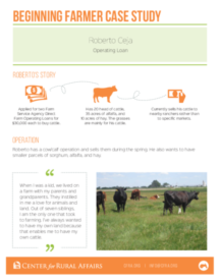Roberto has 20 head of cattle, 35 acres of alfalfa, and 10 acres of hay. He also wants to have smaller parcels of sorghum, alfalfa, and hay. The grasses are mainly for his cattle. Currently, he sells his cattle to nearby ranchers rather than to specific markets.
A love for animals and land
When I was a kid, we lived on a farm with my parents and grandparents. They instilled in me a love for animals and land. Out of seven siblings, I am the only one that took to farming. I’ve always wanted to have my own land because that enables me to have my own cattle.
Help from others to start
At first, I didn’t have anyone to guide me. I met with other local farmers during a community meeting. They inspired me to look into U.S. Department of Agriculture (USDA) assistance. I also had a positive experience with Matt Meyer, the local Farm Service Agency agent, and Lucia Schulz with Center for Rural Affairs, who gave me the confidence to create a business plan and apply for an operating loan.
Advice to beginning farmers/ranchers
My advice to anyone is that if you love agriculture, then stick with it, because it is a lot of hard work. It takes passion, love, and courage to farm.
Challenges
There have been a lot of challenges this year—I lost some cattle due to the harsh winter, and also lost all my alfalfa recently due to flooding. It had been raining for almost three days straight. I want to continue trying until I can’t do it anymore.
Recommendations to USDA agents
I would like USDA to consider systems other than loans or cost share. These systems require beginner farmers to get into debt quickly and run the risk of failing. I thought after a beginner farmer has gone through an evaluation about their seriousness in farming, USDA could give them, let’s say five or 10 goats, or several pounds of seeds for free.
The beginner farmer would have a set time to double his harvest or livestock, and once they have doubled their business, they return half of their yield. This would be a revolving door process. Then, beginner farmers wouldn’t get into debt quickly. I have heard other countries implement this type of system.
Experience with USDA
[My agent] was great; very knowledgeable and flexible when it came to changing the meeting times, because at times it was almost impossible to get off work.
This case study was produced with funding through the U.S. Department of Agriculture’s Outreach and Assistance for Socially-Disadvantaged Farmers and Ranchers (2501 Program) and Veteran Farmers and Ranchers Program. The Center for Rural Affairs is an equal opportunity provider and employer.


